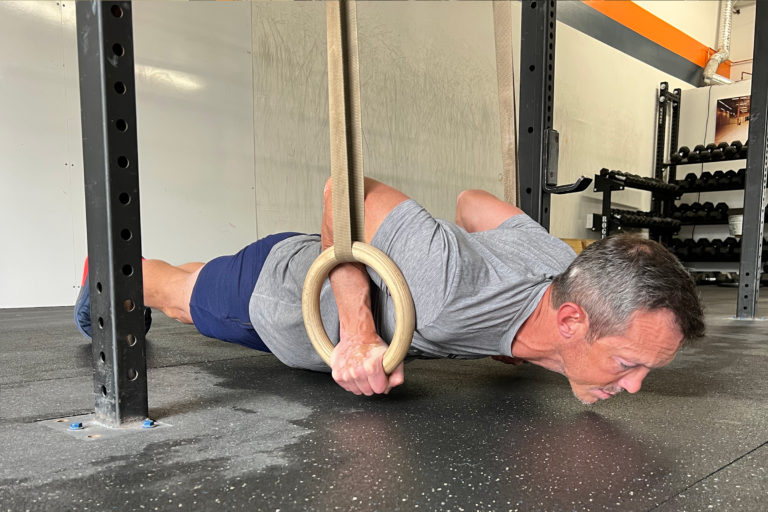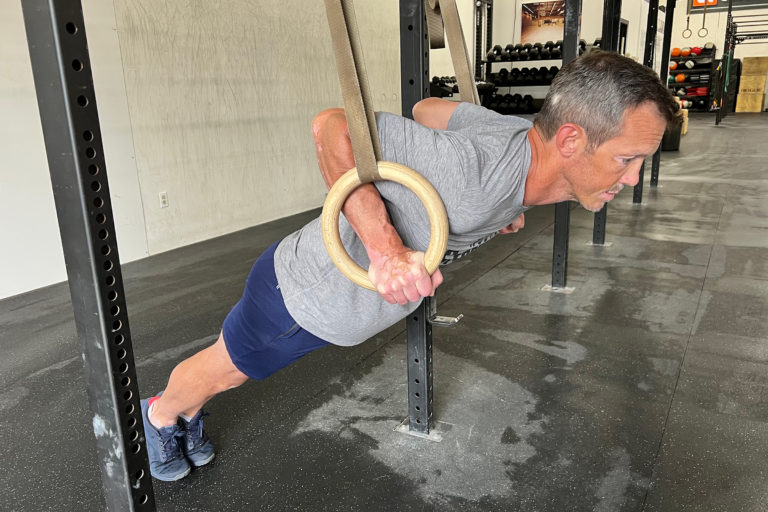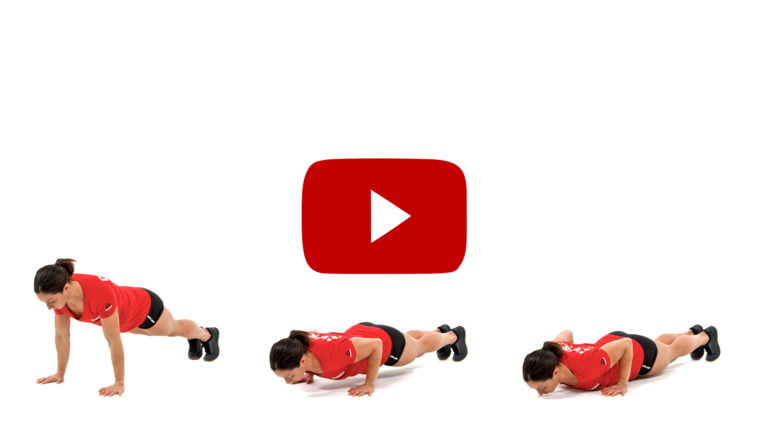The push-up is considered by many to be the cornerstone of basic body-weight strength training. Even though this movement is well known and simple to perform, it is also difficult to complete with correct mechanics and full range of motion. Many individuals will walk into your gym with the notion that they can’t do push-ups or that push-ups are too difficult for them. Others may view this movement as being “too simple” or “too easy” but are enlightened when a coach teaches them that their push-up is actually just half of what is required. Regardless of an individual’s level of fitness, this movement can provide value and can be modified to provide a challenge for any level of athlete. It is necessary for the coach to have a variety of options that athletes can use to assist with the development of this exercise as well as to achieve the desired stimulus of a given workout and to avoid boredom. Consider the following variations when scaling this movement:
Kneeling Push-ups
For most coaches and athletes, this tends to be the first scaling option as it is easy to implement and many athletes will have success. The major pitfall with this exercise is that it tends to be overused and athletes may not progress as quickly as they could if they were exposed to different or increasingly challenging options. Another pitfall is that the knees act as the pivot point, preventing the athlete from practicing stabilizing their entire body as is required by the full movement.

Foam Roller Push-ups
This variation allows for the athlete to keep a long body position while reducing the difficulty of the movement. Athletes can experiment with the roller position that allows them to achieve the desired stimulus for the day. The roller placed above the knees can be a starting point and athletes can increase the difficulty by placing the roller below the knees. As the roller is placed closer to the feet, the demand on the midline to stabilize and resist extension increases.

Incline Push-up
The incline push-up is another staple for modifying the movement. This variation assists with teaching athletes to maintain a stable body position and also provides an easy means to increase or decrease the difficulty for any level of athlete. Those needing significant assistance can start by using a high box (or any stable surface) while those who need less assistance can place their hands on a lower-height object. Note: Depending on the height of the box, athletes will make contact at various places on the chest while maintaining a straight body position.

Banded Push-ups: Three Variations
Bands are not just for pull-ups! Bands can also be used in a variety of ways to assist with performing push-ups. An added benefit to these banded variations is that they accommodate resistance. The bands will provide athletes the most assistance at areas of the movement that are weakest (bottom) and will assist athletes less at areas of the movement that are typically strongest (the top). Check out the following options to include in your athlete’s training:
- Band suspended from a pull-up bar
Loop a band to the pull-up bar, place the band around the midsection, and crank out the reps. This variation of the push-up can be used to assist nearly any level of athlete throughout the entire range of motion of the standard push-up. The strength of the band tension or the height of the pull-up bar can be adjusted to increase or decrease the difficulty as needed.

- Banded J-Hook
Attach a band to two J-hooks in a stable squat rack and position yourself over the band near the midsection. A tendency with this exercise is to flare the elbows out to the side to avoid making contact with the band, so ensure that the band is in a position that does not interfere with proper elbow placement. Similar to the previous banded option from a pull-up bar, the difficulty of this exercise can be modified by changing the band tension or raising/lowering the J-hooks. This variation allows for an easy progression over time. Athletes can start at a high height on the J-hooks and can gradually work their way toward the floor.

- Banded “Sling Shot”
This banded variation does not involve using the pull-up rig, which is an added benefit for quick transitions and if the pull-up rig is being used for other movements. Fold a band in half and create a loop, then place your arms into the band. The difficulty of this exercise can be modified by raising or lowering the placement of the band on the arms. A potential pitfall of this exercise is that there may be some discomfort of the band rubbing against the skin of the arms.

Regardless of the push-up variation being performed, strive to complete the movement while maintaining the foundational mechanics of the exercise. Some simple focus points are:
- Start with a hand position approximately shoulder-width apart with fingers facing forward or slightly out.
- Maintain a stable body position throughout the entire range of motion by squeezing the quads, glutes, and abdominals. Focusing on these points will also keep your hips and shoulders moving at the same rate on the descent as well as the ascent.
- Touch the chest to the floor (or surface if using an incline push-up).
- The elbows should move back and stay relatively tight to the body, although slightly out from the body is acceptable.
- Strive for the shoulders to move forward slightly as the elbows start to bend on the initiation of the descent.
Check out this demo video for a rundown of the proper execution of this movement:
Bonus Push-up Challenges
Consider the following variations for some variety if you want a new challenge. These variations can be performed in conditioning workouts but the utility may be best served as strength work or challenges and accessory work to be performed pre- or post-workout.
Hand-release Push-ups
This variation is performed in the same fashion as the traditional push-up but with a full hand release from the floor. The release of the hands and the lengthened time on the floor takes away some of the stretch reflex advantage of the traditional push-up and increases the difficulty.

Deficit Push-ups
Increasing the range of motion increases the difficulty of the push-up and can also provide a stretch for the pecs and shoulders. Athletes can place each hand on a set of plates, dumbbells, kettlebells, parallettes, etc. to provide the additional range of motion. Athletes can still reach their chest towards the floor as long as the range of motion can be achieved without hyperextending the trunk.

Ring Push-ups
The ring push-up provides additional difficulty due to the demand to stabilize the rings. The ring push-up can be a friendly variation for many levels of athletes as it is easy to decrease the difficulty of the movement. Athletes can push the rings forward into an incline position or can even use band assistance to perform the movement.


Weighted Push-ups
Regardless of ability level, a push-up can be used for strength training at low reps. If a partner is available, a fun challenge can be to attempt a 3-5-rep-max weighted push-up. Have the partner place the load across the back of their partner’s shoulders while in the starting position and give it a go!

Band-Resisted Push-up
Bands can be used in a variety of ways to increase the difficulty of the movement. A simple variation is to place the band behind the upper back and put each hand in the band. An additional benefit is that banded variations will provide the least resistance at areas of the movement where the athletes are typically weakest (the bottom) and provide the most resistance where athletes are typically strongest (the top).

Varied Hand Placements
Athletes can vary the placement of the hands to provide an additional challenge or to work musculature in a different fashion. The narrow grip or “diamond” push-up is notorious for being difficult to perform. Athletes can get more creative than simply narrowing or widening the hands and can perform push-ups with staggered hand positions, off-set push-ups, or even with the fingers pointing towards the toes.

Feet Elevated
Similar to how the push-up can be made easier by elevating the hands, the push-up can be made more difficult by elevating the feet. Athletes should still strive to reach the chest to the floor and perform the push-up with sound mechanics. Therefore it is recommended to use a box height that allows the range of motion to be achieved without hyperextending the trunk.

Tempo Challenge
Slowing down the tempo or adding a pause during the movement is an effective way to increase the difficulty. A couple fun challenges are to:
- One rep of the longest push-up possible. The caveat is that the athlete must perform the lowering phase and upward phase at the same cadence. For example, if the athlete performs the lowering phase in 15 seconds, then the upward phase must be performed in 15 seconds as well.
- Hold the chest 4-6” from the floor as long as possible. The athlete must remain stable in this position for the duration of their effort. Any deviation upward or downward stops the time.

Plyo Push-ups
There are several variations of plyometric or explosive-style push-ups that can be performed. A simple start could be to perform a push-up where the hands just leave the ground after the press. Common variations include performing a clap or multiple claps after the hands leave the floor. If looking for a fun challenge, athletes can attempt to clap their hands in front of their body and then behind their backs — this is a risky one!
A depth/drop push-up is also a common explosive style of push-up. Start with the hands elevated a few inches on plates or on a small box, then drop down into a push-up on the floor and explosively push the hands back to the elevated surface. For an additional challenge, athletes can increase the height of the plates/box or perform this movement for max height.

As you can see, there are a great number of push-up variations that can be performed to provide fun challenges, variety, and options for athletes at all skill levels. As a reminder, performing the classic push-up with pristine mechanics will be the goal for most individuals who come into the gym. Keep a focus on the basics and progressing athletes over time. Throw in some of the additional challenges occasionally to mix things up.
About the Author
Eric O’Connor is a Content Developer and Seminar Staff Flowmaster for CrossFit’s Education Department and the co-creator of the CrossFit Competitor’s Course. He has led more than 300 seminars and has coached in an affiliate since 2010. He is a Certified CrossFit Coach (CF-L4), a former Division 1 collegiate wrestler, and one time he competed at the CrossFit Games.
Comments on A Fresh Take on the Lowly Push-up
Ring push-ups might be a good option as well. when you hold gymnastics rings in hands and push-up from the floor, not rings hanging on straps from the bar.
I like the depth push-ups.
26:03 with pistols to a 5 gallon bucket
Fantastic article !!
Fantastic article !!
Thank you!
i will most assuredly be sharing this with my people.
this will be so handy it will keep the attention.
Great article! Thanks for all the detailed info, videos, and variations. Looking forward to your next fresh take.
Good article. Push ups are great and all the variations are often overlooked.
Now to programme a few surprises in the box :)

A Fresh Take on the Lowly Push-up
13